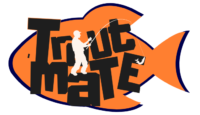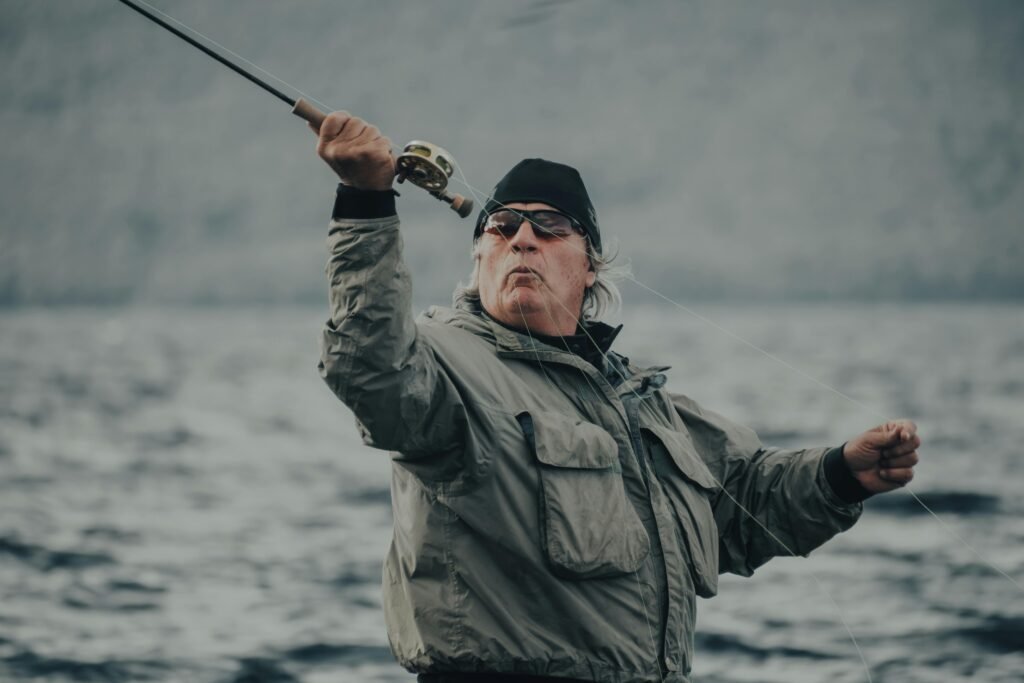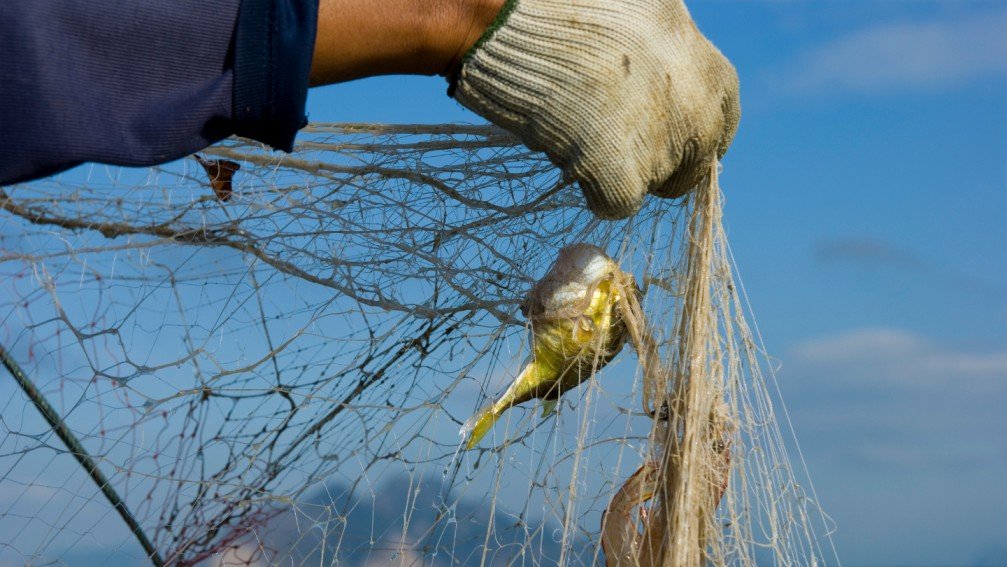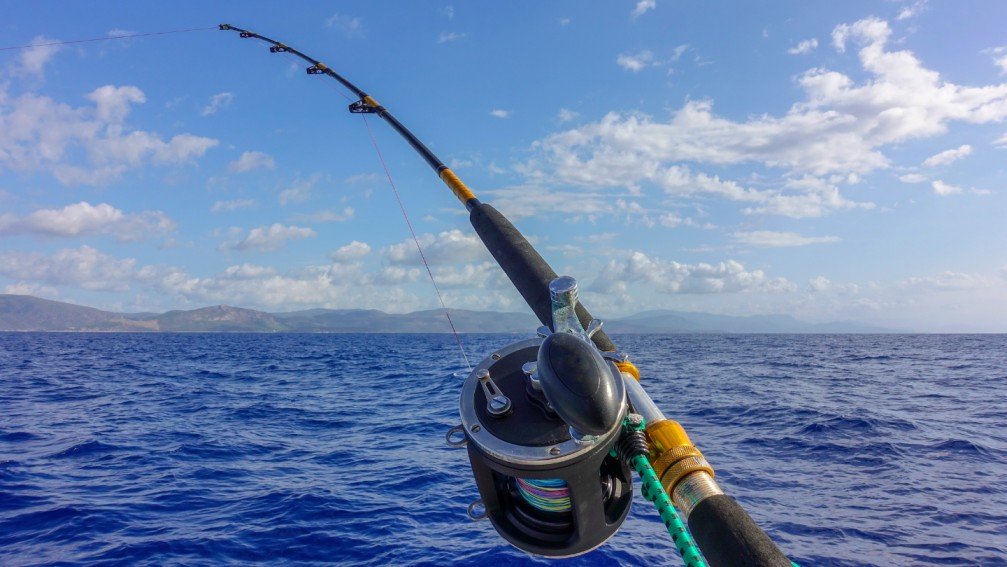To cast a fly rod, start with a smooth backcast, then perform a forward cast. Ensure your wrist remains steady.
Fly fishing is an engaging and rewarding sport that requires skill and patience. Casting a fly rod accurately involves mastering a few essential techniques. Beginners often struggle with this aspect, but practice makes perfect. Start by learning the basic backcast and forward cast motions.
Use your wrist sparingly to maintain control. Proper timing and coordination are crucial for a successful cast. Investing time in practice can significantly improve your performance. Fly fishing offers not just a hobby but a way to connect with nature. Mastering the cast opens up a world of fishing opportunities and experiences.
Introduction To Fly Casting
Fly casting is an essential skill for anyone who loves fly fishing. It involves using a fly rod to cast a lightweight fly line. This allows you to place the fly accurately and gently on the water.
Why Fly Fishing?
Fly fishing offers a unique and immersive experience. It connects you with nature and requires patience and skill. Many people find it relaxing and rewarding. Here are some reasons why fly fishing is popular:
- Close connection with nature
- Challenge of mastering the technique
- Variety of fish to catch
- Opportunities to explore new places
Basics Of Fly Casting
Understanding the basics of fly casting is crucial. These basics help you cast effectively and accurately. Let’s break it down into simple steps:
- Grip the Rod: Hold the rod with a firm but relaxed grip.
- Stance: Stand with feet shoulder-width apart.
- Back Cast: Lift the rod to 1 o’clock position.
- Forward Cast: Flick the rod forward to 10 o’clock position.
- Release: Let the line go at the right moment.
Practicing these steps will improve your casting. Remember to keep your movements smooth and controlled. Consistency is key in fly casting.
Credit: www.reddit.com
Essential Gear
To master fly fishing, you need the right gear. The right gear ensures better control and success. This section covers the essential gear for casting a fly rod.
Choosing The Right Rod
Your fly rod is the most important tool. A good rod helps you cast farther and more accurately. When choosing a rod, consider the following:
- Length: Rods typically range from 7 to 10 feet. A 9-foot rod is a good all-around choice.
- Weight: The rod’s weight should match the type of fish you target. For trout, a 4 to 6-weight rod is ideal.
- Action: Rods can be fast, medium, or slow action. Fast action rods are stiff and good for long casts. Medium action rods offer a balance. Slow action rods are flexible and good for short casts.
Selecting The Best Line
The line is crucial for a successful cast. It carries the fly to the target. Here’s what to consider:
| Line Type | Description |
|---|---|
| Floating Line | Best for beginners. Floats on the water surface. |
| Sinking Line | Sinks below the surface. Good for deep water fishing. |
| Sinking Tip Line | Tip sinks, rest floats. Good for varied water depths. |
Must-have Accessories
Apart from the rod and line, other accessories help improve your fly fishing experience:
- Reel: The reel stores your line. Choose one with a smooth drag system.
- Leader: Connects the fly to the line. Use a tapered leader for better casting.
- Flies: Imitate insects fish eat. Carry a variety of flies.
- Waders: Keep you dry while fishing in water. Choose breathable and durable waders.
- Fly Box: Stores your flies. A waterproof fly box is best.
With the right gear, you’re ready to cast a fly rod effectively. Enjoy the experience and catch more fish!
Casting Techniques
Mastering various casting techniques is crucial for effective fly fishing. Different casts help you adapt to different fishing conditions. Here are some fundamental techniques every angler should know.
The Basic Cast
The Basic Cast is the starting point for all fly fishing techniques. Follow these steps:
- Start with your fly rod in a 10 o’clock position.
- Move the rod back to the 2 o’clock position.
- Pause briefly to let the line extend behind you.
- Move the rod forward to the 10 o’clock position.
- Release the line smoothly.
This simple cast is perfect for short distances.
The Roll Cast
The Roll Cast is ideal when there’s no room for a back cast. Follow these steps:
- Start with your rod tip low, near the water.
- Lift the rod to the 10 o’clock position.
- Create a small loop of line behind the rod.
- Push the rod forward and down, straightening the line.
This cast helps you fish in tight spaces.
The Double Haul
The Double Haul cast increases distance and line speed. Follow these steps:
- Start with a basic cast setup.
- Pull down on the line with your non-rod hand as you move the rod back.
- Repeat the pull as you move the rod forward.
- Release the line during the forward cast for extra distance.
This advanced cast requires practice but offers great rewards.
Perfecting Your Form
Learning to cast a fly rod can seem tricky. But with the right form, it becomes easier. Perfecting your form involves several key steps. Let’s dive into the essentials.
Grip And Stance
Your grip and stance are the foundation of a good cast. Hold the rod with a firm but relaxed grip. Place your thumb on top of the rod handle. This provides control.
Stand with your feet shoulder-width apart. Your weight should be balanced evenly. Face your target with a slight angle. This stance helps you maintain stability.
| Key Element | Details |
|---|---|
| Grip | Firm but relaxed, thumb on top |
| Stance | Feet shoulder-width, balanced weight |
Back Cast
The back cast is crucial for a successful fly cast. Start with the rod tip low. Lift the rod slowly, keeping the line taut. As you lift, accelerate smoothly. Stop abruptly when the rod is at the 1 o’clock position.
- Start with the rod tip low
- Lift the rod slowly
- Accelerate smoothly
- Stop at 1 o’clock position
This motion will create a loop in the line. The loop should be tight and smooth. Practice this to perfect your back cast.
Forward Cast
Once your back cast is in place, it’s time for the forward cast. Begin by pausing briefly at the top of the back cast. Then, move the rod forward with a smooth acceleration. Stop abruptly at the 10 o’clock position.
- Pause briefly at the top
- Move the rod forward smoothly
- Stop at the 10 o’clock position
This motion will propel the line forward. Aim to keep the loop tight and straight. The forward cast is all about timing and control.
Practice these steps regularly. Perfecting your form takes time but is worth the effort.
Common Mistakes
Learning to cast a fly rod can be tricky. Many beginners make common mistakes that hinder their progress. Understanding these mistakes will help you improve faster and enjoy the process.
Incorrect Timing
Timing is crucial in fly casting. One common mistake is rushing the cast. You need to wait for the line to fully extend behind you before starting the forward cast.
Here’s a simple tip:
- Count to three after your back cast before starting the forward cast.
Another timing issue is starting the back cast too soon. This can lead to tangled lines and poor presentation.
To avoid this:
- Watch your line and ensure it straightens out before the next move.
Poor Line Control
Proper line control is essential for accurate casting. A common mistake is not managing the slack in your line. Too much slack can lead to weak casts.
To improve line control:
- Keep your rod tip low to the water.
- Strip in excess line before casting.
- Use your non-dominant hand to manage the line.
Another issue is not maintaining tension during the cast. Without tension, your line will not load the rod properly.
Remember to:
- Keep a slight bend in your rod during both the back and forward casts.
Overpowering The Cast
Many beginners think casting requires a lot of force. This is a mistake. Overpowering the cast often results in a poor presentation and can spook fish.
Instead, focus on:
- Using smooth, controlled motions.
- Letting the rod do the work.
Using too much power can also cause your fly to land too hard. This scares away fish and makes the cast ineffective.
Practice using just enough power to get the line where you want it. You’ll find that a gentle approach often works best.
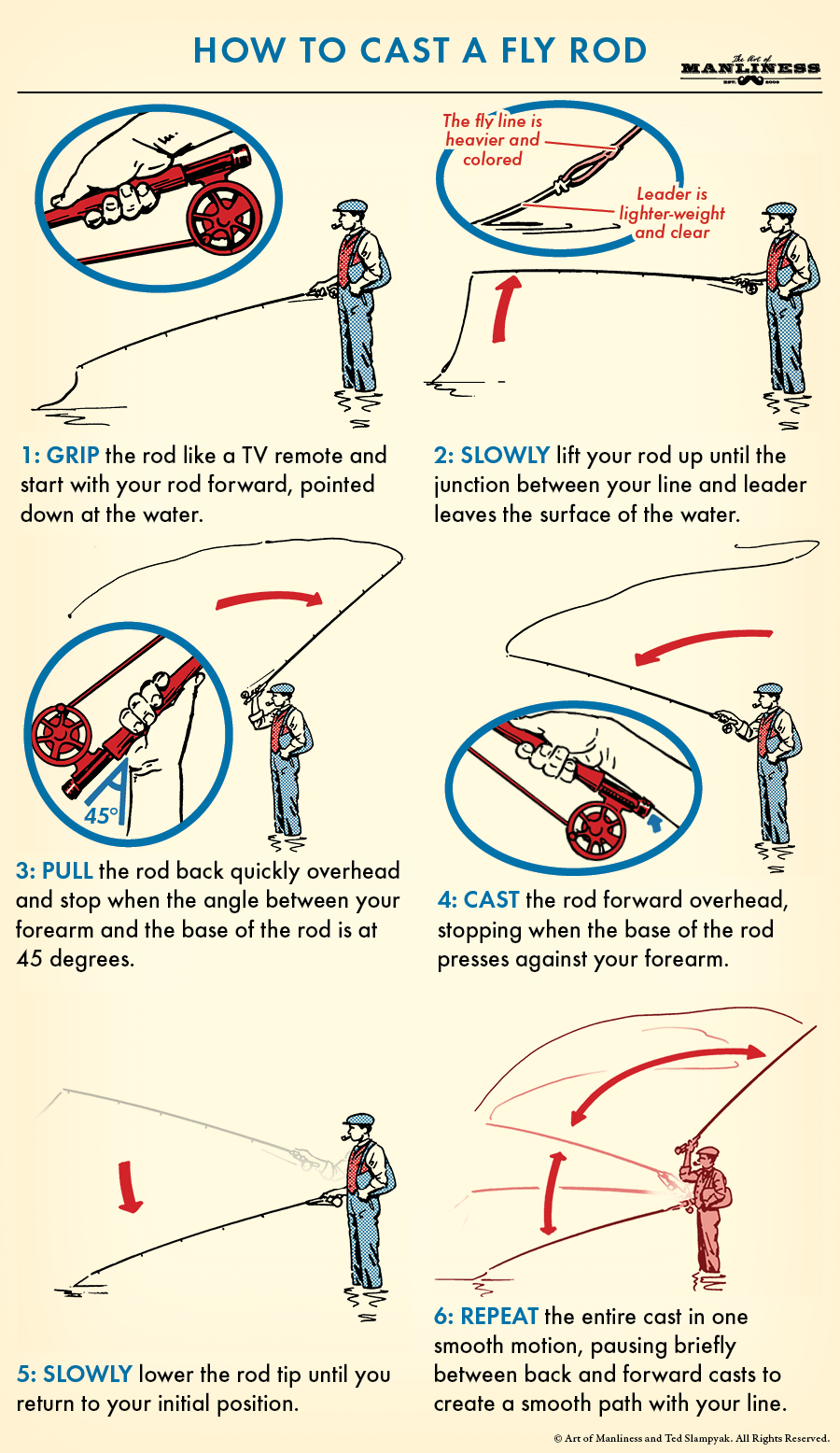
Credit: www.artofmanliness.com
Advanced Tips
Once you’ve mastered the basics of fly rod casting, it’s time to level up your skills. Advanced casting techniques can help you handle challenging conditions, achieve longer casts, and improve your accuracy. Below are some advanced tips to refine your fly rod casting skills.
Casting In Windy Conditions
Casting in the wind can be tricky. Here are some tips:
- Use a heavier line: A heavier line can cut through the wind better.
- Adjust your casting angle: Cast lower to the water surface.
- Shorten your line: Less line means less wind interference.
These adjustments can make windy days more manageable.
Improving Distance
Increasing your casting distance can help cover more water. Try these tips:
- Double haul technique: This gives you extra line speed.
- Proper rod loading: Make sure your rod is fully loaded before the forward cast.
- Smooth acceleration: Gradually increase speed for a more powerful cast.
These techniques will help you reach farther distances with ease.
Accuracy Techniques
Hitting your target is crucial in fly fishing. Enhance your accuracy with these tips:
- Focus on a target: Aim for a specific spot, not just the general area.
- Practice casting drills: Set up targets and practice hitting them.
- Maintain a straight line path: Keep your rod tip moving in a straight line.
Improving accuracy will make your casts more effective.
Know How To Set The Hook
Practice Drills
Practice drills are essential to mastering fly rod casting. These drills help improve accuracy, timing, and muscle memory. By integrating indoor, outdoor, and partner drills, you can become a more skilled fly caster.
Indoor Drills
Indoor drills are perfect for rainy days or limited outdoor space. You can practice basic movements and techniques without needing water or open space.
- Shadow Casting: Use a mirror to watch your form.
- Target Practice: Set up small targets around the room.
- Line Control: Practice controlling the line on the floor.
Outdoor Drills
Outdoor drills provide real-world conditions. They help you adapt to wind, water, and natural obstacles.
- Distance Casting: Measure and mark distances in your yard.
- Accuracy Challenges: Aim at various targets like hoops or cones.
- Wind Practice: Cast during different wind conditions.
Partner Drills
Partner drills are interactive and provide feedback. Working with a partner can highlight areas for improvement.
- Feedback Loop: Your partner watches and comments on your form.
- Simulated Fishing: Act out fishing scenarios together.
- Competition: Friendly casting competitions to test skills.
| Drill | Description |
|---|---|
| Shadow Casting | Use a mirror to watch your form. |
| Target Practice | Set up small targets around the room. |
| Line Control | Practice controlling the line on the floor. |
Maintenance And Care
Proper maintenance and care of your fly rod ensure it lasts longer. A well-maintained rod performs better and provides a more enjoyable fishing experience. Let’s look at some essential tips for keeping your gear in top shape.
Cleaning Your Gear
Always rinse your rod with fresh water after each use. This removes dirt and salt. Pay special attention to the guides and reel seat. Use a soft cloth to wipe down the entire rod. Avoid using harsh chemicals, as they can damage the finish.
Regularly check the reel for sand and debris. Remove the spool and clean it with a gentle brush. Lubricate the moving parts with a few drops of reel oil.
Storing Your Rod
Store your fly rod in a cool, dry place. Avoid direct sunlight, which can weaken the materials. Always use a rod tube or sock to protect it from scratches and impacts Make sure the rod is completely dry before storing. Moisture can cause mold and corrosion. Disassemble the rod into its sections and store them separately if possible.
Repair Tips
If your rod breaks, don’t throw it away. Many repairs are simple. For a broken tip, use a rod tip repair kit. Follow the instructions carefully for best results.
For cracks in the rod, apply a small amount of epoxy resin. Allow it to cure fully before using the rod again. If the guides are damaged, replace them with new ones. Use a guide replacement kit for this task.
Check the cork handle regularly for wear. Sand it lightly to remove dirt and smooth out rough spots. Apply a sealant to keep it in good condition.
Mastering the art of fly rod casting takes practice and patience. Remember to keep your movements smooth and deliberate. With time, you’ll improve your casting accuracy and distance. Enjoy the process and embrace the learning journey. Happy fishing, and may you experience many successful casts!
Read : How To Clean a Fish
FAQs:
What Is The Best Way To Cast A Fly Rod?
The best way to cast a fly rod involves smooth acceleration, a firm stop, and proper timing. Practice the 10 o’clock to 2 o’clock casting motion. Keep your wrist firm and focus on your line control. Regular practice improves technique and accuracy.
How Far Should I Be Able To Cast A Fly Rod?
You should be able to cast a fly rod between 30 to 50 feet. Practice improves distance and accuracy.
Can You Practice Casting A Fly Rod Without A Fly?
Yes, you can practice casting a fly rod without a fly. Use a piece of yarn or a practice plug.
How Do You Hold A Fly Line When Casting?
Hold the fly line with your non-dominant hand. Grip it lightly with your fingers. Keep the line taut for control. Release the line gradually during the forward cast. Maintain tension to ensure smooth casting.
